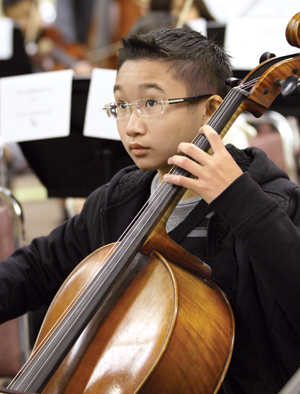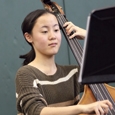 In the quest to teach more advanced repertoire to young string players, directors and sectional coaches often neglect some fundamental orchestral concepts. Be sure to explain clearly the following basic guidelines to students.
In the quest to teach more advanced repertoire to young string players, directors and sectional coaches often neglect some fundamental orchestral concepts. Be sure to explain clearly the following basic guidelines to students.
Equipment
Each member of the orchestra should bring a sharpened pencil with a working eraser to rehearsals. Encourage students to keep at least one pencil in their instrument case. Next to the instrument and bow, the pencil is the most important tool. The next step is to frequently remind less-experienced musicians to write suggestions from the conductor and section leader into the music. At first they may need explicit instructions about how and where to mark their parts.
Provide students with a checklist of what should be inside the instrument case. In addition to pencils, each player should have rosin, a mute, extra strings, and nail clippers. Instruments and bows should be properly maintained. For example, show students what a fraying string or crooked bridge looks like or how to tell when a bow should be rehaired.
String Parts
Elementary and intermediate string parts usually come from publishers with acceptable bowings and fingerings. This is less often true for advanced orchestral literature. Parts may be full of distracting markings from previous students. If you do not have a designated librarian, form a group of students to serve as a task force to clean up illegible music and enlarge hard-to-read print.
Bowings
The parts need to be bowed with age-appropriate bowings that are coordinated between sections. Bowings that work well for professional orchestras do not always work for a school or youth group where the players present different levels of ability. Always recheck bowings before giving parts to the players. Often bowings used previously may seem inappropriate. Music borrowed from others may not have well-organized bowings.
Start by marking bowings in a score to make sure the bowings match between the sections. When you mark the individual parts, it is helpful to write bowings in throughout the music to help the students stay on track. (More advanced groups will tend to write fewer markings and know to follow the pattern.) This is especially useful during a typical start and stop rehearsal.
Ultimately it will save precious rehearsal time if every part (including the score) has measure numbers marked in the left margin. Measure numbers are better than rehearsal letters that are often far apart and difficult to locate.
While working on bowings, insist that all bow strokes should match: on or off the string; frog, middle, or tip. Remind students to write these details in their parts. If you have sectional coaches, ask them to assist with this. Many private teachers are reluctant to help students with orchestra parts due to lack of time in lessons. This is unfortunate because school, youth, college, and later community orchestras will be the primary performance outlet for most string students.
If you do not have coaches readily available, there are usually local teachers and performers who would be happy to help. Do not be afraid to ask. As labor intensive as editing string parts is initially, the investment leads to more efficient rehearsals and a stronger performance.
Marking the Parts in Rehearsal
Students should mark directions from the conductor, sectional coach, or section leader (bowings, tempo changes, etc.) immediately at rehearsal. Again, younger students should be reminded to do this frequently until it becomes a habit. This also applies to any personal markings such as fingering choices or accidental reminders. Players should mark an X in the margin to identify spots they should practice at home.
A standard procedure in professional orchestras is for outside players to put their fingerings on top of the notes while the inside players put their fingerings below the notes. This helps players keep track of which fingerings are their own.
Tempo changes are not always printed in the music and are subject to the individual ideas of the conductor. Players should mark them as they rehearse and not rely on rote drill. Professional musicians have developed a shorthand for this: a forward arrow indicates a faster tempo or accelerando and a backward arrow represents a ritard or slower tempo. Often a squiggly line is used to point out a ritard.
Neatly written beat marks (or simply writing in 2 or in 4) can be useful for indicating a change in meter or clarifying a conductor’s beat pattern. This is also helpful after a long rest or a page turn.
During a long series of rests, parts should include instrumental cues (cello melody, second violin entrance, etc.). Every player should count long rests (not just the section leaders) and stay actively involved in the rehearsal even when they are not playing.
Page Turns
The inside player almost always turns the pages. One exception is when a divisi passage would cause the loss of the bottom note when the inside player drops out to turn the page. In this case the page turns should alternate between inside and outside players by stand.
If a quick turn is required, this should be indicated at the bottom of the page. The turn should occur early enough to enable the outside player to start the top of the next page in time. This often means that the inside player drops out a few beats or a measure early. Most of the time, a page turner will not have time to put the instrument and bow down. Instead the musician turns the page from a playing position. For a violinist or violist, this means transferring the bow to the left hand and leaning in to the stand to turn the page. If there are rests at the bottom of the page, these should be rewritten at the top of the next page.
Divisi
For two-part divisi the outside person usually plays the top line, while the inside player covers the bottom part. For three-part divisi, it is easiest to divide by stand. The first stand would play the top part, second stand the middle part, and third stand the bottom part. Four-part divisi can vary based on the passage in question. Sometimes it is easiest to divide by person, sometimes by stand.
Pizzicato
Often music requires a quick change from arco to pizzicato or vice versa. In this case, players do not have time to move the bow to the palm of the hand and instead will have to pluck from a playing bow hold. Be sure to show students how to accomplish this when such a place occurs, so they do not lose time trying to move to a standard pizzicato position.
Seating Position
Ideally all stands should have a clear view of the conductor, the first stand of each section, and each other. Visual communication is important, especially for ensemble and bowing style, and should not be blocked by a large music folder or stand pushed up too high. Risers can be very helpful for players sitting in the back of sections.
In order to increase individual involvement in the music, each stand should switch places for a few rehearsals (excluding the first stands). This will insure that no one feels stuck in the back of the section. Professional orchestras do this routinely and call it revolving seating. Players in the back of sections need to watch even more than listen. They need to anticipate their motions to stay synchronized with the rest of the section. Revolving seating allows players who move from the front to the back to have a clearer picture of the interplay between visual and aural skills.
Section Leaders
Choose your section leaders carefully. These players should be responsible and enthusiastic. Each string section should have a principal and an assistant. Often two players rotate between these positions throughout the year. These players act as a liaison between the conductor and section members. They communicate both on and off the stage with the other section leaders and perhaps even with principals in the wind and brass sections. In addition to playing incidental solos, the leaders are responsible for cuing section entrances in a rhythmically solid manner.
A well-organized and disciplined orchestra will perform at a higher level, and the experience is ultimately more enjoyable and valuable for the players. Approaching ensemble playing with clear guidelines and organization teaches students important skills that will help them both in music and in life.





